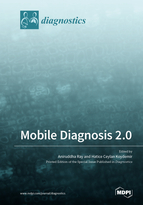Mobile Diagnosis 2.0
A special issue of Diagnostics (ISSN 2075-4418). This special issue belongs to the section "Point-of-Care Diagnostics and Devices".
Deadline for manuscript submissions: closed (31 August 2020) | Viewed by 35507
Special Issue Editors
Interests: point of care biosensors; mobile imaging and sensing; nanotechnology; optical imaging and spectroscopy
Special Issues, Collections and Topics in MDPI journals
2. Center for Remote Health Technologies and Systems, Texas A&M University, 600 Discovery Dr, College Station, TX 77843, USA
Interests: micro-fabrication; lab-on-chip; biosensors; BioMEMS; non-invasive diagnostics
Special Issues, Collections and Topics in MDPI journals
Special Issue Information
Dear Colleagues,
Mobile sensing and diagnostic capabilities are becoming extremely important for a wide range of emerging applications and fields, spanning mobile health, telemedicine, point-of-care diagnostics, global health, field medicine, democratization of sensing and diagnostics tools, environmental monitoring, and citizen science, among many others. This Special Issue will focus on these application areas and provide a timely summary of cutting-edge results and emerging technologies in these interdisciplinary fields.
Prof. Dr. Aniruddha Ray
Dr. Hatice Ceylan Koydemir
Guest Editors
Manuscript Submission Information
Manuscripts should be submitted online at www.mdpi.com by registering and logging in to this website. Once you are registered, click here to go to the submission form. Manuscripts can be submitted until the deadline. All submissions that pass pre-check are peer-reviewed. Accepted papers will be published continuously in the journal (as soon as accepted) and will be listed together on the special issue website. Research articles, review articles as well as short communications are invited. For planned papers, a title and short abstract (about 100 words) can be sent to the Editorial Office for announcement on this website.
Submitted manuscripts should not have been published previously, nor be under consideration for publication elsewhere (except conference proceedings papers). All manuscripts are thoroughly refereed through a single-blind peer-review process. A guide for authors and other relevant information for submission of manuscripts is available on the Instructions for Authors page. Diagnostics is an international peer-reviewed open access semimonthly journal published by MDPI.
Please visit the Instructions for Authors page before submitting a manuscript. The Article Processing Charge (APC) for publication in this open access journal is 2600 CHF (Swiss Francs). Submitted papers should be well formatted and use good English. Authors may use MDPI's English editing service prior to publication or during author revisions.
Keywords
- point of care biosensors
- global health
- telemedicine
- mobile imaging and sensing
- lab on a chip








